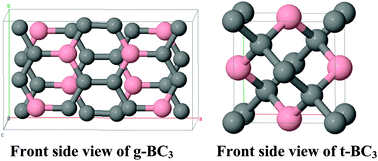Specific features of electronic structures and optical susceptibilities of g-BC3 and t-BC3 phases
Abstract
Details of comparison for some specific features of electronic structures and optical susceptibilities of g-BC3 and t-BC3 phases are provided. Calculations show that the g-BC3 phase is a narrow band gap semiconductor constructed from the ABAB stacking sequence. Whereas t-BC3 is a metallic phase constructed by a sandwich-like metal–insulator lattice from an alternately stacking sequence of metallic CBC and insulating CCC blocks. The two phases possess only two types of bonds (B–C and C–C). The density of states at the Fermi level N(EF) of the t-BC3 phase is determined by the overlapping of B-2p and C-2p empty orbitals of the CBC block with C-2p empty orbitals of the CCC block, and the shape of the Fermi surface originated from these empty orbitals. The B atoms cause a small perturbation on the C-ring's structure and hence to the charge density distribution. The linear optical properties of the two phases confirm the existence of the lossless regions and the considerable anisotropy. The second harmonic generation of the t-BC3 phase shows that χ(2)123(ω) is the dominant component of about 3.9 pm V−1 at the static limit and 5.8 pm V−1 at λ = 1064 nm, which suggests that the t-BC3 phase could be considered as a promising nonlinear optical material in comparison with the well known KTiOPO4 nonlinear optical single crystal.


 Please wait while we load your content...
Please wait while we load your content...